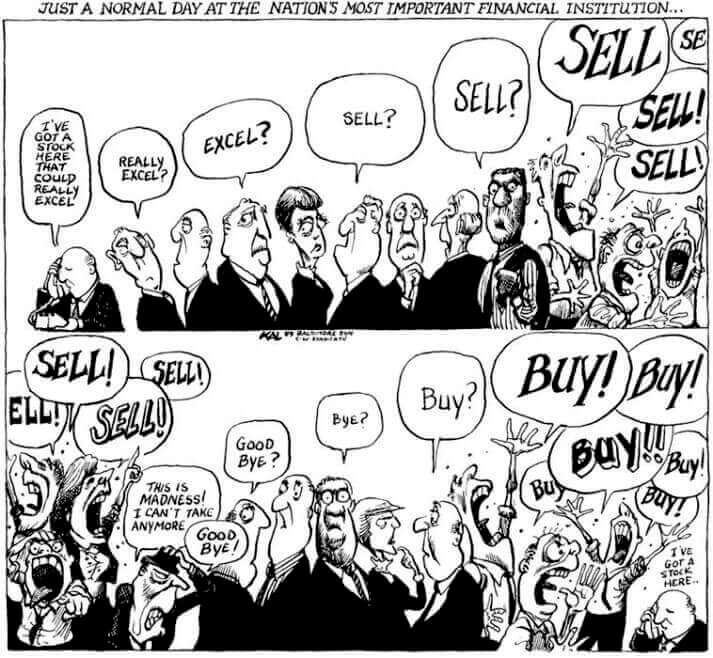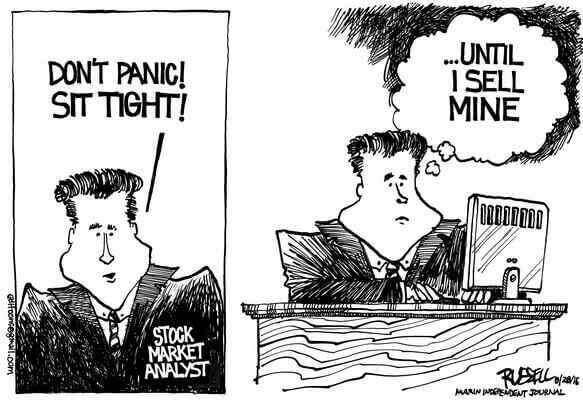This cryptocurrency trading guide takes a look at a major question often discussed in the cryptocurrency market, “Do Charts & Technical Analysis Really Work?”
Perhaps the greatest misconception ever told in the crypto world is, ‘Chart’s don’t work’.

Personally, as a trader and an avid fan of charts and everything related to the process of technical analysis, I find that this statement inaccurate. Not only that, the statement just simply isn’t rooted in objective facts.
This statement usually comes from not only a lack of fundamental understanding as to how these markets work, but a misunderstanding of charting and technical indicators as well. This article would go in-depth on the inner workings of the market and argue why charting – and technical analysis for that matter – is an effective tool for any investor or trader. (See also: 4 Reasons Why Now is the Best Time for You to Invest in Cryptocurrencies)
Market Psychology
Let’s start with the assumption that human psychology is at the root of all investment decisions made by market participants. In order to further explain this assumption, let's imagine that you've just opened lemonade stand.

When you release your lemonade stand stock as an IPO and it hits the markets, everyone has the option of offering a price on it. The price of your stock at any given moment in time is what the market values it at. Now, this could be ‘accurate’ or ‘distorted’ depending on who you talk to about it. Perhaps some people have a lot of faith in your work ethic and your prowess as a business owner and they feel confident enough in your vision to grab as much of your lemonade stand stock as possible. Based on their knowledge of what they feel other really successful lemonade stand companies trade for, they’re confident that the current price of $8/stock is an absolute steal. In their minds, they believe that you’ll grow the company to the point where each share will be worth $50/stock one day. (Read more: Crypto ICO vs. Stock IPO: What’s the Difference?)
Buyers Vs. Sellers: Getting the Best Price
Those people that really believe in your stock will buy up as much of those $8/stocks as they possibly can if they really feel this way. Why not? However, in order for them to be able to buy your stock for $8/share, they need to find someone else that feels that the price will not increase in the short or long-term beyond $8/share. Because, after all, if they did think that were the case, then they wouldn’t be selling the share in the first place. They would feel $8 is way too low for them.
Perhaps they ask for $10, but others are looking to buy it for $8. Therefore, both parties decide they can compromise and ‘meet in the middle’ at a price of $9. The new price of your lemonade stand company after the first day of trading will thereafter be $9/share. This – in many ways – reflects how the market generally values your company. This is the equilibrium price between those who believe in the potential upside of your business versus those that wants to liquidate due to a variety of reasons. See also: Cryptocurrency Accounting Guide: How Do I Calculate My Crypto Gains?)
Now Here’s Where Market Psychology Really Kicks In
Most of these people that are investing in your company have the sole intention of making money. They aren’t doing so because they love you so much and they want nothing more than to see you win in this life. So, let’s say John bought a bunch of your stock at $9/share. Thereafter, the price of your lemonade-stand stock skyrockets all the way up to $20/share. At this point, John has already made more than 100%+ profit. (Read also: Bitcoin vs Alt Coins Returns: Comparison of Gains Between Bitcoin & Altcoins Investing)

The fact that the price of your stock has gone up means two things:
- Greater Demand / Buying Pressure: Before the price traveled from $9 to $20 (market price), a shift in the market had to occur where there were more people willing to buy the stock at $9 than there were willing to sell it. So, eventually all the folks that were willing to sell the stock at $9/share either already sold their holdings or they made the realization that the appetite for this stock is so strong, that they should probably be asking for a higher bargaining price.
- Sellers Sitting Back: Those that were offering to sell your lemonade stand stock are now reconsidering. Now that they can see the price is going up, they’re starting to withdraw their sell offers because they see that the demand for the stock is going up, which will naturally raise the price.
The combination of these two factors is what typically creates a ‘bull run’ in any stock or security. Other investors that observe what’s going on start to join in the party too and buy up the stock because they see,
‘Hey, everyone wants that lemonade stand stock. It used to be $9/share and now it’s $20/share! I should get in on this too!’
What brings things down, however, is the fact that people like John who bought the stock at $9/share may start to get antsy. At a certain point, John realizes that people will pause and ask themselves, ‘Why the hell am I paying $20+/share for this lemonade stand company?’ Eventually the price of the lemonade stand company will reach a point where new investors won’t want to enter into the market because they see the value of the stock as being way too expensive for them. Let’s say $21 is that threshold where people make that determination that the price of the stock is just way too much for a lemonade stand company, no matter how good it is! (Read also: Understanding Cryptocurrencies: Game of Thrones Edition)
A Shift Would Occur in the Market
The ‘buy orders’ would start to decrease rapidly. Those that bought the stock for $20 will realize that there are hardly any players in the market that are willing to purchase it for above that price. Those like John who bought the stock at $9 and feel that the price of the lemonade is reaching a tipping point will more than likely sell at the $20/share price mark. Why not? That’s a solid profit for John. (See more: Is it Too Late to Buy Bitcoin and Is It too Late to Invest in Cryptocurrency?)
A Cascading Effect

Others like John will attempt to sell at the $20 price mark, but they’ll find that the amount of people willing to buy it at that price have all but disappeared. Now there are only those that are willing to buy the lemonade stand stock for $19. However, those who just bought that stock at $20, may start to panic. They might look at this stock that they paid $20 and notice that it’s now going for $19 and then think to themselves,
‘Oh my, I just paid $20 for something that’s already going for $19! What’s going on?’
Most of them will start to panic a little once all the $19 buyers dry out and the market price goes to $18. Thereafter, they’ll start to sell their stock as well at a loss because they’d rather take that 10% loss (from $20 to $18), than to risk the price going all the way down to $10 or $11, where they’d take a way steeper loss. (See also: Analyzing Cryptocurrency Risk: Existing Coins vs ICO)
So, in addition to the people that bought at $9 and $10 whom are now selling to take profit, people that bought the lemonade stand stock at $20 are also selling in order to minimize their perceived losses. Of course, buyers can observe that the market price for the lemonade stand company has been dwindling, so buyers begin to dry up even faster. The goal of investing is to make money, so most investors won’t buy something if they feel like the price is going to go down right after they buy it. That’s antithetical to the whole process.
(Read more: Crypto Trading Guide: 4 Common Pitfalls Every Crypto Trader Will Experience)
See the Rabbit Hole We Just Traveled Into?
That’s how stocks/securities and yes, cryptocurrency, work. It has everything to do with how the market is valuing a certain derivative product or security at a given time.
The beauty of technical analysis is that it helps us to determine how the market is feeling at a given time.
If you’re a smart investor, you know that there’s only so much that you can learn from looking at the market price of something at a given point in time. Most people would want to know what the price has been historically. Is at a high? A low? What was it valued at when the day began? What did the market value it at last year? Did it suddenly plummet in the last 2 months? Why? Maybe the market knows something you don’t. (See more: Guide on Identifying Scam Coins)
That’s Technical Analysis
Technical analysis represents a methodology of evaluating investments which involves a statistical analysis of market activity, that primarily includes as volume and prices. It does not attempt to measure a security’s intrinsic value, but rather utilize price charts and indicators to identify patterns that can be used as a basis for investment decisions. These patterns are a manifestation of the psychology of the market, made up of emotional individuals like you and me.
Beneficial Resources To Get You Started
If you're starting your journey into the complex world of cryptocurrencies, here's a list of useful resources and guides that will get you on your way:

Trading & Exchange
- Crypto Guide 101: Choosing The Best Cryptocurrency Exchange
- Guide to Bittrex Exchange: How to Trade on Bittrex
- Guide to Binance Exchange: How to Open Binance Account and What You Should Know
- Guide to Etherdelta Exchange: How to Trade on Etherdelta
- Guide To Cryptocurrency Trading Basics: Introduction to Crypto Technical Analysis
- Cryptocurrency Trading: Understanding Cryptocurrency Trading Pairs & How it Works
- Crypto Trading Guide: 4 Common Pitfalls Every Crypto Trader Will Experience
Wallets
- Guide to Cryptocurrency Wallets: Why Do You Need Wallets?
- Guide to Cryptocurrency Wallets: Opening a Bitcoin Wallet
- Guide to Cryptocurrency Wallets: Opening a MyEtherWallet (MEW)
Read also: Guide on Privacy Coins: Comparison of Anonymous Cryptocurrencies and Crypto Beginners Guide: 5 Things Crypto Newbies Should Know
Get our exclusive e-book which will guide you on the step-by-step process to get started with making money via Cryptocurrency investments!
You can also join our Facebook group at Master The Crypto: Advanced Cryptocurrency Knowledge to ask any questions regarding cryptos!

I'm Aziz, a seasoned cryptocurrency trader who's really passionate about 2 things; #1) the awesome-revolutionary blockchain technology underlying crypto and #2) helping make bitcoin great ‘again'!

